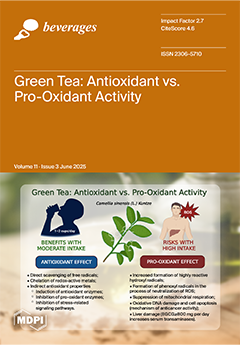Pisco is an emblematic spirit in Peru and Chile, made from fermented grapes, gaining growing scientific interest over the last two decades. This study aimed to map 20 years of research on Pisco through a systematic bibliometric review. A search was conducted in the Scopus database covering the period from 2004 to 2024, applying the Preferred Reporting Items for Systematic Reviews and Meta-Analyses (PRISMA) methodology for the transparent selection of scientific articles. The search strategy considered titles, abstracts, and keywords, using the terms “
Pisco” and “
schnapps”, excluding unrelated fields such as geology (basin, seismic, fossil). The initial search yielded 360 records. After removing non-original articles (books, book chapters, conference papers, and reviews), 101 articles remained. A further screening excluded irrelevant studies (e.g., those referring to the city of Pisco rather than the beverage), resulting in 78 articles included for final analysis. It was observed that 19% of the studies focus on the history, culture, and appellation of origin; 14% on environmental sustainability; 10% on innovation and quality; and 9% on the bioactive properties of by-products. Other areas include extraction technologies (9%), distillation process modeling (8%), and marketing and economics (8%), among others. Recent trends are related to clean production practices. Thus,
Pisco by-products and their components can be exploited by applying technologies such as supercritical fluids, drying, and biofilms, while, for waste management, the processes of composting, solar photo-Fenton, and ozonation can be applied. Moreover, it is important to highlight that the valorization of
Pisco by-products opens opportunities for translation into the market, particularly in developing cosmetics, nutritional supplements, and bio-packaging materials, contributing to sustainability and innovation in new industries. However, a more holistic view is still needed in
Pisco research. These findings suggest that future research should prioritize the integration of consumer-based sensory evaluations and sustainable production innovations to optimize
Pisco’s quality, enhance market acceptance, and promote environmentally responsible industry practices.
Full article





